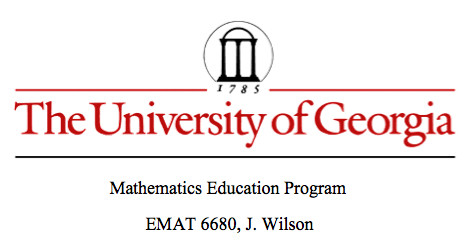
Exploring Centers of Triangles
by
Laura Kimbel
There are 4 very important ways of viewing the center of a triangle. We can look at its CENTROID, ORTHOCENTER, CIRCUMCENTER, and the INCENTER.
The centroid is the first center and is obtained by locating the intersection of the three medians of the triangle. The median of a triangle is obtained by joining each vertex with the midpoint of the opposite side. See the figure below.

The second center of a triangle is the orthocenter. It is obtained by finding the intersection of the 3 altitudes of the triangle. An altitude is found by joining each vertex with the point on the opposite side that creates a perpendicular line with the opposite side. See the figure below.

The third center is the circumcenter. The circumcenter is the intersection of the perpendicular bisectors of each side of the triangle. We can also think of this center as the point that is equidistant from each of the vertices. Since it is equidistant from each vertex, we can also construct a circle that passes through each vertex with the center being the circumcenter. See the figure below.

The last center is the incenter. The incenter is found by first constructing the angle bisectors of each of the three angles. The incenter is the intersection of these 3 segments. See the figure below.

Now we can look at all 4 centers on the same triangle and see how they relate to each other. In the image below, we have the Centroid (G), the Orthocenter (H), the Circumcenter (C), and the Incenter (I).

Notice that 3 of the 4 centers lie on a line segment. We call this segment the Euler Line. There are certain cases when all 4 points lie on the Euler Line and also a case where all 4 centers are the same point. Let's now see what happens to the 4 centers as we examine different types of triangles.
First let's look at an isosceles triangle:

This triangle has 2 sides of equal length. You can see that in these types of triangles, all 4 centers lie on the Euler Line.
Equilateral Triangle:

In this triangle, all 4 centers are the same point.
Obtuse triangle:

We still have the centroid, the orthocenter, and the circumcenter lying on the Euler line but now, the orthocenter and the circumcenter lie outside the triangle.
Acute Triangle:

The triangle above has all 4 centers located within the triangle and the incenter, in this case, is not located on the Euler line. We could however construct an acute triangle on which the incenter does lie, if the acute triangle happens to also be isosceles.